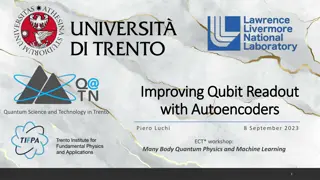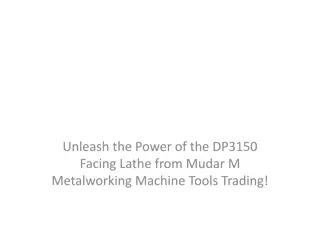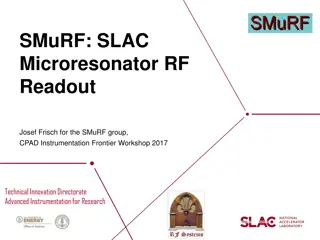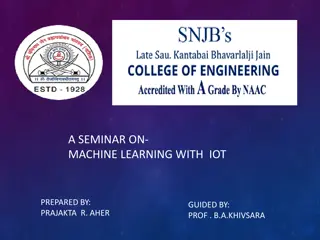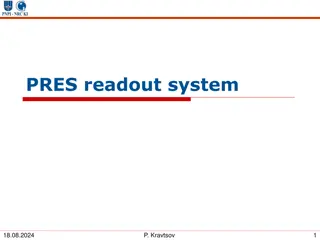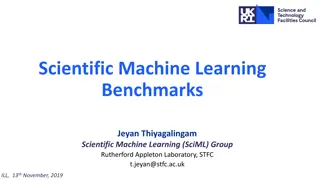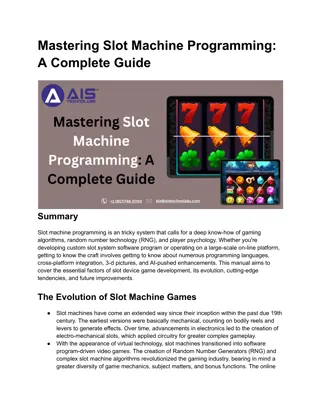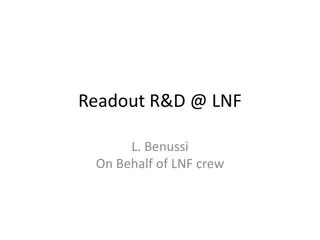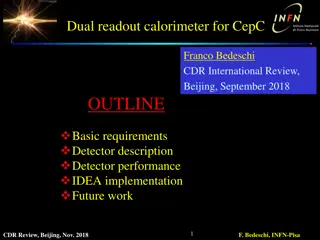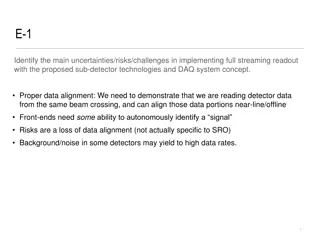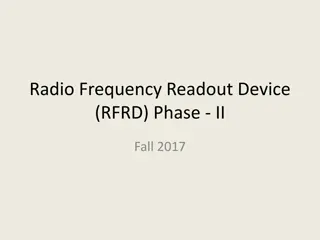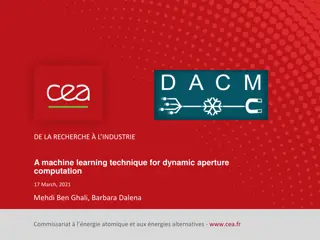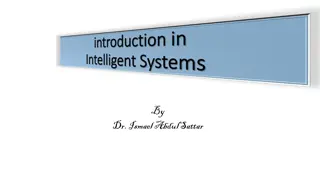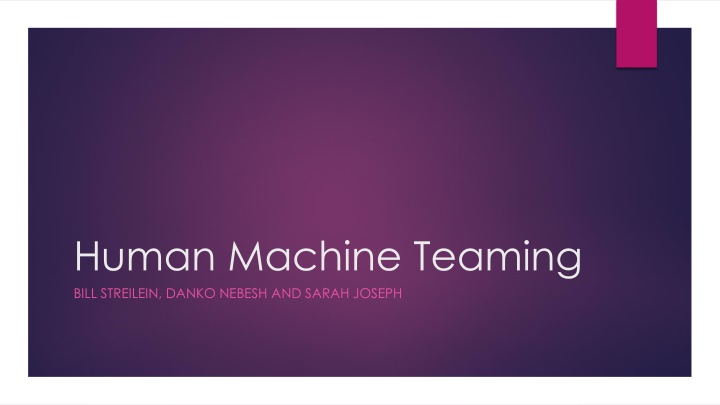
Evolution of Human-Machine Teaming and Cyber Use Cases
Explore the evolution of human-machine teaming in the context of theory of mind, quantification, interactions, and cyber use cases for security and dynamic honeypots. Discover how machine learning and machine translation can enhance cybersecurity efforts and address challenges in identifying and responding to potential threats effectively.
Download Presentation

Please find below an Image/Link to download the presentation.
The content on the website is provided AS IS for your information and personal use only. It may not be sold, licensed, or shared on other websites without obtaining consent from the author. If you encounter any issues during the download, it is possible that the publisher has removed the file from their server.
You are allowed to download the files provided on this website for personal or commercial use, subject to the condition that they are used lawfully. All files are the property of their respective owners.
The content on the website is provided AS IS for your information and personal use only. It may not be sold, licensed, or shared on other websites without obtaining consent from the author.
E N D
Presentation Transcript
Human Machine Teaming BILL STREILEIN, DANKO NEBESH AND SARAH JOSEPH
Human-Machine Teaming Track: Focus Areas Theory of Mind Theory of mind broadly refers to humans' ability to represent the mental states of others, including their desires, beliefs, and intentions Context As decision makers interact with a dynamic task, they recognize a situation according to its similarity to past instances, adapt their judgment strategies from heuristic-based to instance-based, and refine the accumulated knowledge according to feedback on the result of their actions Interactions ...Challenges for making automation components into effective "team players" when they interact with people in significant ways Quantification Accurately and effectively measuring system performance of an HMT is crucial for moving the design of these systems forward
Track Evolution Theory of Mind Context Quantification Interactions Cyber Use Cases Metrics Sharing Anthropomorphism Research Directions
Cyber Use Cases for HMT Security offices assistant Monitoring DDoS attack or Exfiltration of a large file Is there an attack? What should I do about it? Support analysis Investigate in more detail than normal for examples in which novel zero-day attacks are encountered. System thinks something bad is happening user disagrees. What does the team do?
Cyber Use Cases for HMT Dynamic honeypots. Where should you be putting your resources for honeypots? Having an agent allocate resources for honeypots. Intermittent Monitoring How can you look at information once a day, once a week and quickly orient. Network Monitoring - DDoS at Bank of America. 60 people working together to keep bad traffic out. Could ML reduce number of people? Could MT reduce Human to human - high pressure communication? How can an agent pair with a novice user in a cybersecurity position? MT can draw analogies with historic data that users may not know about. Take advantage of computers good at bookkeeping capabilities.
Cyber Use Cases for HMT Spear phishing MT can help identify suspicious inputs, emails. MT can form, ask, and evaluate authentication question. Target data breach Can MT using ML identify and reduce false positives
Metrics - Data Having a dataset that we can test against. What data do we need? Historical Red/Blue Shared testbed challenge style Can we trust it? What data do you show human? What data do you show MT? How can you measure it if you do not show all the data? If MT fails, can I do an analysis with generated data? is the data overtraining or non-representative?
Metrics - Communication What is the common ground? How do we move metrics to the information domain? What does it mean to be understood by a computer? How many tasks can we monitor at once? What does it mean to be understood by a human? How do we discover hidden states and when do we show it to the human? Failure states of the machines (When is it going to fail). Prompts you to ask questions you should be asking. What percentage of the machine s capability are you using? How do you share information of multiple humans of different levels and job roles? How confident are you in either decision? How do you test for failure and find the models that fit?
Metrics - effectiveness of human- machine team system Is the team balanced (in terms of what)? What are the confidence intervals on the decisions of the machine? Need metrics beyond accuracy and speed, such as trust How do you move from cyber physical to the information domain What are the tools that are being used for human-machine teaming domains? How many tasks can be monitored at once? How do these apply to the team? How do you measure cognitive load? How do you train a human to know what capabilities they aren t doing? How do humans interact w/ these systems? How do we instrument the human to give feedback to the machine What % of the machine is being used? What level of coverage for a job role is being utilized? Can you measure how ethical a HMT s decisions are?
Metrics - for judging effectiveness of human-machine team system. How do we instrument the human to give feedback to the machine Can you measure how ethical a HMT s decisions are? How can cyber phenomena be measured?What metrics matter? What is self measurement for a machine or human to judge performance? How do we measure importance? Does a computer or a host say what matters? Find a metric for mission importance of devices How do you bootstrap a novice using data collected on experts?
Sharing People + machine are better than an individual. Power of using passive voice, and what it might do to power imbalance, where things are more suggestive in nature Suggestions from machines that would not be taken critically. Machines asking are you sure ? At random times Prompts affect decision-making process Discourse, argumentation with/from a system Interfaces? 2D, 2.5D, 3D, natural language, graphical? System randomly asks are you sure? how might this impact analytic tradecraft
Sharing I don t need to understand how it works, but someone should. Semi-autonomous cars Antilock breaking SPAM filters Google assistant Levels of abstraction of common ground Mismatch between H and MT Figure out how to overcome mismatch Levels of fidelity and abstraction necessary to gain/maintain trust
Sharing What to share? Specification of goals Exposure of intent Joint activity Teammate continuum of what is shared Mechanics for sharing including nonverbal cues Boundary definition
Sharing Relationship structures Equals? Hierarchical Role based Others Analogy to programming paradigms Functional Imperitive Others
Sharing Argumentation and Discourse What will it look like? What paradigms are effective? How does this differ from H-H discourse? What to base it on? Language Philosophy Developmental psychology Sociology Library science
Sharing Role of machine learning What models do we use? Are existing techniques sufficient? Decision process exposition Worst case reachability Is it safe? Machine metacognition and reflection
Anthropomorphism Will it help with work or a task. Low fidelity, demographic effects. An effective interface has emotional feedback. Effectiveness may depend on the type of work you re doing. Emotional feedback. Adoption issues with interfaces that give emotional feedback. How can effective computing with emotional feedback help give security advice? What are the questions for using something with face feedback or other emotional feedbacks?
Anthropomorphism Using multiple AIs to help in decision-making and to build more trust. Comparing the performance of AIs over a period of time. Learning the personalities of multiple AIs. Too many AIs could lead to misleading. Multiple AIs federated by one AI How do you build trust with AI? May feel manipulative or insincere.
Anthropomorphism Not always needed or desired, depends on work type Doesn t need to mimic humans Behaviors needed Human is like coach/quarterback Machine is teammate/lineman
Anthropomorphism Adoption issues Slow feature creep Adjustment time needed to build trust assess risk Non-technical users misuse asleep at the wheel Have one AI you build relationship with Add new features Work/life team family based Do H & MT bonds transfer to others Voting amount multiple AI s builds trust AI s optimized for different purposes
Research Ideas (1/2) Assumption: Machine Teammate must have capability for independent action and joint activity and not just be a tool or analytic. A cyber environment is one where the machine is working much faster than the human, What is the appropriate framework for human machine teammate interaction to not just include task interaction but include trust and theory of mind. How does the human still participate? What are the touchpoints? What information exchange needs to be supported base on elements of the task and goals? What is the mode of the exchange? How do we map the attributes to the information that needs to be shared? What are the possible structures of sharing and interaction? For a given task what is the appropriate composition of humans and machine teaming?
Research Ideas (2/2) How do you have a discourse between the MT and H? Sharing information can calibrate trust. What type of information needs to be shared? How much information should be shared? Context dependant. How do we evaluate? What would it take for a machine to explain why it didn t do something? Does the MT adhere to human ethics when looking at data? My AI is not working towards my best interests but is working ethically adhering to privacy expectations.

